
 |
This was my first official night time photo shoot of 2021 not from the backyard. With restrictions easing and the Easter break it was time for the first arranged night shoot with a mate this year. Easter was earlier this year and much to the annoyance of many it was in complete contrast to this time last year when we had an extended heat wave, 2021 was the complete opposite with a high pressure Arctic air mass and cold Nly flow which produced cold days and even scattered hail and snow showers. However there was a silver lining in the form of clear skies, we ended up with at least three exceptional clear nights in a row which coincided with dark moonless skies, this would be perfect for what I wanted.
An observing session was arranged for Friday April 4th with photographer John Fagan. This was to be mainly a visual session as we would be bringing our telescopes however we would have the cameras with us anyway and would likely shoot a star trail or a time lapse, we had a new location in mind which we would try later in the night. Even though I have been observing the night sky from my backyard with the new telescope I had yet to test it out under a truly dark sky so I was eager to see what it could do, John also had the exact same telescope and he was in a similar mind set so our goal was to observe deep sky objects and have a good relaxing time under the stars. If you don't already know we both own Meade's 10" F/5 Lightbridge truss tube Dobsonian reflector, we chose the truss tube design to make the telescope more portable for traveling to dark sites. From my home in Cookstown I can grab a range of deep sky objects however due to light pollution from the town, street lights, and my horizon being obstructed by houses my observing tends to be limited to certain sky sectors, furthermore the truss tube design lets in stray light onto the primary mirror causing reflections and a bright background star field, home makes do for training but for serious observing dark skies are required so this was our goal this night.
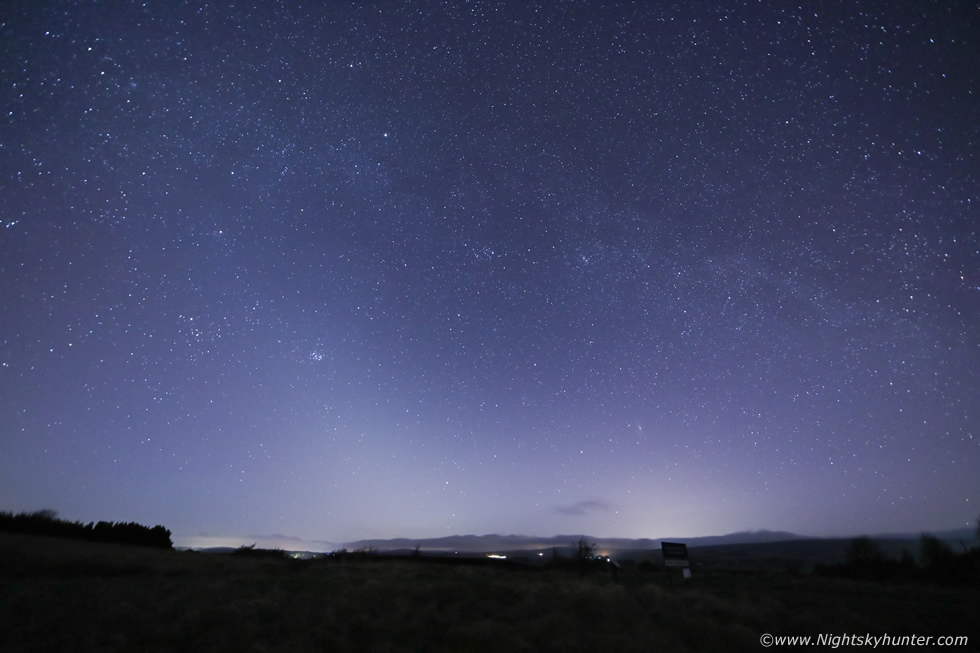 |
I was able to pack the optical tube assembly (OTA) into the back of the van and used various coats and a rolled up sleeping bag to cushion it during transit. The rocker box sat perfectly on the passenger seat, I secured it in place with the seat belt. The process of removing the OTA from the rocker box was relatively swift and easy to do. I met John at the car park beside Beaghmore Stone Circles just as twilight was merging into astronomical darkness. John and I agreed it was a mighty fine sky so we set-up our telescopes and let them adjust to the cool night air. Letting a telescope climatize to the ambient air is crucial for steady star images, especially larger aperture instruments which are more more prone to temperature change, this time can vary from 20-30 min's to as much as 60 min's depending on the situation.
As we adjusted to the night we set-up our cameras on location and began shooting a time lapse of the W to NW evening sky where the Milky Way and Zodiacal Light Pyramid where located. We could see the Zodiacal Light (ZL) with the naked eye as a subtle colourless glow shaped like a slanted teepee along the ecliptic plane passing through the Pleiades and fading away before planet Mars between the Hyades and Auriga. The above image is one of the exposures from the time lapse sequence showing the ZL, Milky Way and Andromeda Galaxy (M31) taken with the Canon 5D Mark IV and 15mm F/2.4 lens stopped down to F/2.8, exposure time was 15 sec's at ISO6400. The ZL was less striking compared to it's form we witnessed from this same location last year earlier in March, it was now later and the viewing prospects were less favourable however we were still glad to have seen it once again.
We began observing with our telescopes, the eyepiece height tends to be very low when the telescope is pointing low in the sky so I brought along a small stool to keep me in proximity to the eyepiece, more often than not I tend to be looking low in the sky as this is where I tend to operate the most. For those of you who don't know I used to search for comets, I have been doing this for over 10 years using 8", 10" and 16" telescopes and have logged over 1300 hours of visual searching. I eventually stopped searching due to increased light pollution from home and my other telescope at the time which was heavy and had a restricted FOV, however it was the change in circumstances of comet discovery itself which forced me to make the decision to stop. With so many survey telescopes scanning the skies all night long every night searching for Earth-threatening asteroids and comets it was already well accepted within astronomical circles that amateur visual comet discovery is over.
This is 99.9% true, professional surveys are now discovering all the comets however there have been a few amateur finds made with CCD patrols, but even these are rare. That being said there will always be surprises, photographic and visual searches can still be done in regions close to the Sun where the big surveys cannot penetrate and there's always the chance that poor weather can hamper other parts of the world. Also small out bursting comets can suddenly announce their presence within 90 degree elongation of the sun, these are the prey for the amateur searcher. Despite all this I have already resigned myself to the fact that my dream of discovering a comet is likely over, I still observe every comet which comes within range of my telescopes however the hunter part of me is something which I can't switch off, it's a part of me and that's who I am. If I have a telescope and a dark sky my instincts are to search for that elusive cometary prey.
Just like that I began comet hunting again, I spent 30 minute's sweeping the low W and NW sky through Perseus, Andromeda, W. Cassiopeia and Pisces. I have to say it was a fantastic feeling which felt like being back in the good old days when I done this every night during dusk and before dawn. I simply enjoy sweeping the sky, admiring fields of rich star fields with chance encounters with fuzzy deep sky objects which briefly get my heart pumping when they enter the field, I find the process relaxing and invigorating in equal measure and the thought of not knowing what's going to be in the next field keeps me going. Once finished the sky had darkened completely with stars to mag +6.2 visible to the naked eye so we began a leisurely period of observing. Observing through a fast rich field telescope from a dark sky in the countryside adjacent to an ancient stone circle site was a special moment. The 1.5 degree FOV (3 apparent full moon diameters) at x49 using the supplied 2" 26mm SWA eyepiece provided us with stunning wide vistas of the sky. I observed M41, M44, M45 with Merope Nebula, M31, M32, M110, M76, M34, Double Cluster, M35 and companion NGC cluster, M1, M13, M92, M81, M82, M51, M94, M103, M97, the Leo Triplet, NGC4565 (Needle Galaxy) and M53. Satisfied with seeing these deep sky wonders we packed up the gear then re-located to our new location.
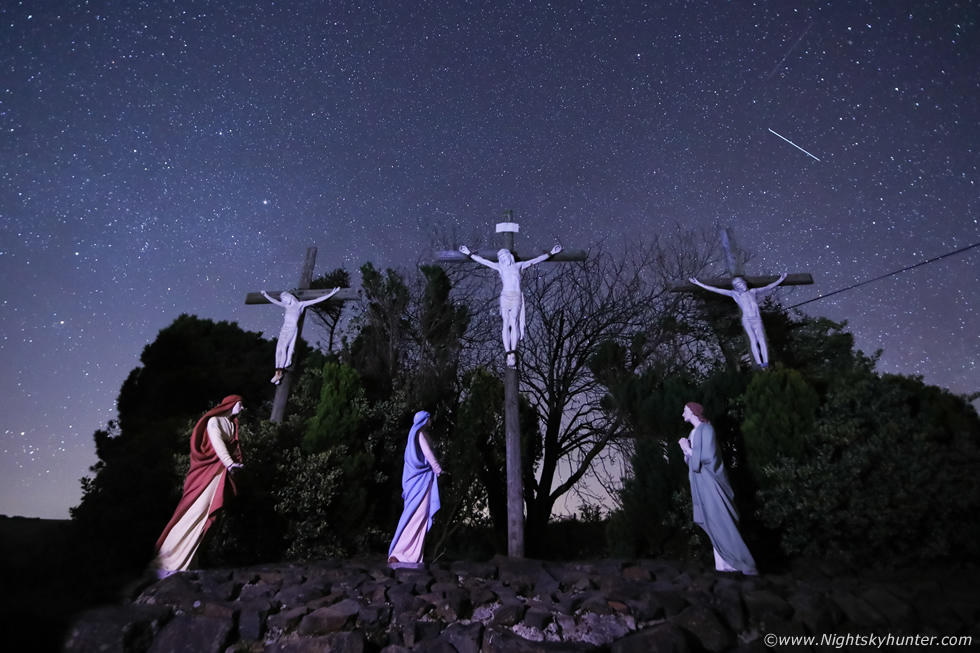 |
It was now well after midnight and John and I had parked at Lady of Wayside chapel in Broughderg. This was our first time here at night and we were very impressed, the sky looked even darker than Beaghmore and Davagh, likely due to a lack of house and farm lights in the area, the transparency seemed to have improved dramatically. We ate snacks and warmed up for twenty minutes then made our way to the back of the graveyard. A dramatic scene dominated the location in the form of three crosses celebrating the crucifixion scene from the New Testament, this was something we had never seen before, it might also have been never captured at night to the best of our knowledge so we were delighted to get trying something new. We took a selection of still images from various angles before setting up a star trail/time lapse position. These were all taken with the full frame with Irix 15mm lens at high ISOs and 15 sec exposures. A quick sweep with the head torch illuminated the figures for us, capturing the crucifixion scene with the stars was quite appropriate for good Friday and Easter weekend. Sections of the Milky Way can be seen with Auriga, Perseus and Lynx, a bright satellite trail can also be seen.
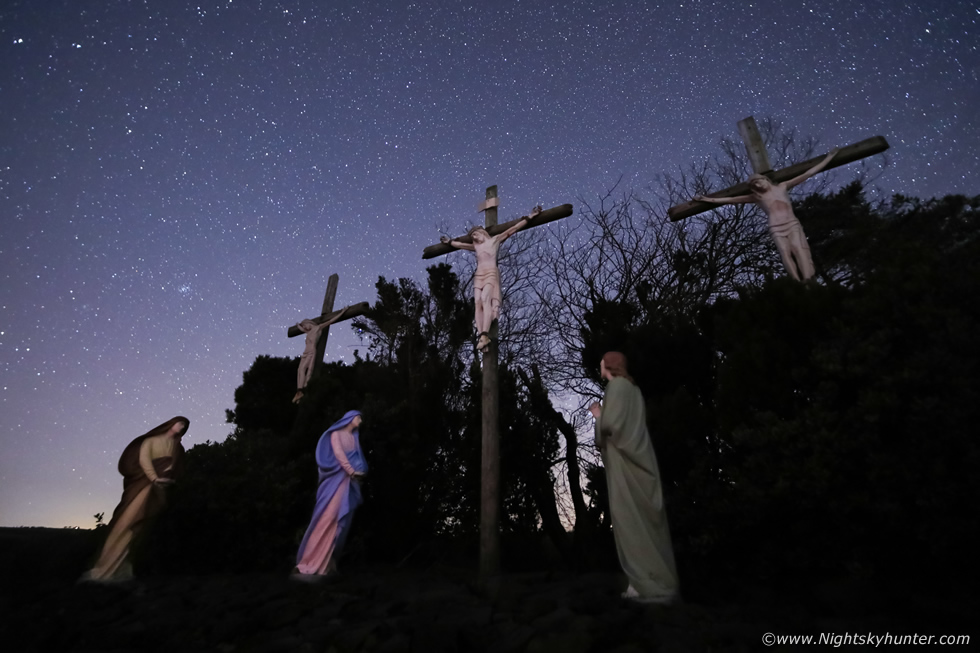 |
I really liked this angle filling the frame up close, can you spot the Beehive Cluster (M44) on the far left?
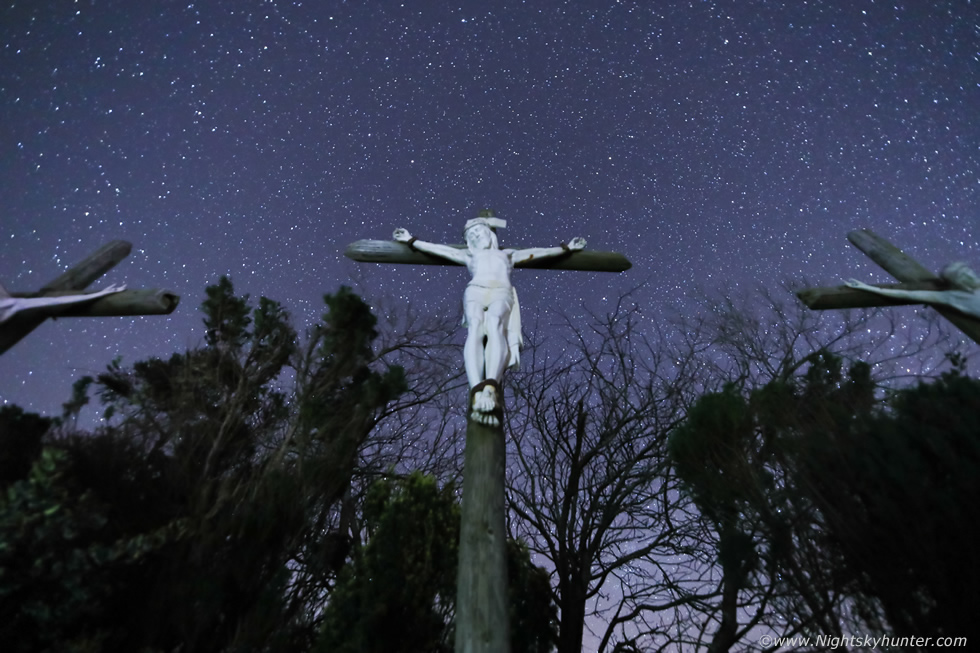 |
I have to admit it felt utterly strange and surreal to be starring up at Jesus against the stars in the middle of nowhere. John and I set up our cameras and began shooting a time lapse. We made sure to use our dew removal systems to stop dew and frost forming on our lenses, this is a curse for a time lapse photographer, many of my personal best lapses at night have been ruined by mist or dew, this time I decided I would do something about it. John was using a lens heater system powered with a portable power bank he purchased online. I used two hand warmers fastened around the lens with elastic bands which worked very effectively. I also set-up a second camera to shoot a star trail around the chapel itself.
We left the cameras alone to do their magic then returned to the car park to get fully dark adapted and take in the sky once more. I set-up the telescope once again as the sky was absolutely pristine. We revisited a few old favorites from earlier however this time John let me use his new x2.5 barlow lens. This lens magnifies any given eyepiece by a factor of x2.5 and it's designed for large 2" barrel designs, with the 26mm it gave a power of x123. We were blown away by the view, M81 had spiral arms, M13 could be resolved almost to the core like looking into a black hole with mottled suns vanishing into the event horizon. M57 was stunning, this Planetary Nebula looked like a glowing smoke ring in a sea of stars within Lyra with varying degrees of twisted segments around its circumference, the view was almost 3-D. The Needle Galaxy showed a central bulge however the show stopper for us was M82 the irregular companion galaxy to M81 located between Ursa Major and Draco, at this time of night they where directly overhead, the seeing and transparency were perfect. We observed dark obscurations and knots and hints of galactic chaos in this spectacular edge-on galaxy which is prone to mighty supernova explosions, we were both in awe of the view. To finish with we had a peep at M51 the Whirlpool galaxy between Ursa Major and Canes Venatici, the sprial arms were clearly visible including the bridge of light connecting M51 with its nearby companion from the NGC catalogue.
I switched back to the wide angle 26mm and swept through the galaxy rich Coma-Virgo cluster, at times up to five galaxies were visible in the same field at a casual glance. I also observed M13's mag +12 companion galaxy NGC6207 located 28 arc minutes from the famous cluster. I also observed binary stars Alberio, Castor and Mizar, I even detected a hint of the reflection nebulosity in Cygnus in proximity to the naked eye star Gamma Cygni. It was before dawn so I settled onto my tiny stool under a heavy frost and spent another hour searching for comets. I hunted through Lacerta, Cepheus, E. Cassiopeia, Cygnus, Lyra, E. Pegasus, Vulpecula, and E. Perseus. I picked up M56, M27, M57, M34, M39 and M29. We were both freezing so I packed away the scope then ventured into the darkness of the head stones to retrieve our cameras.
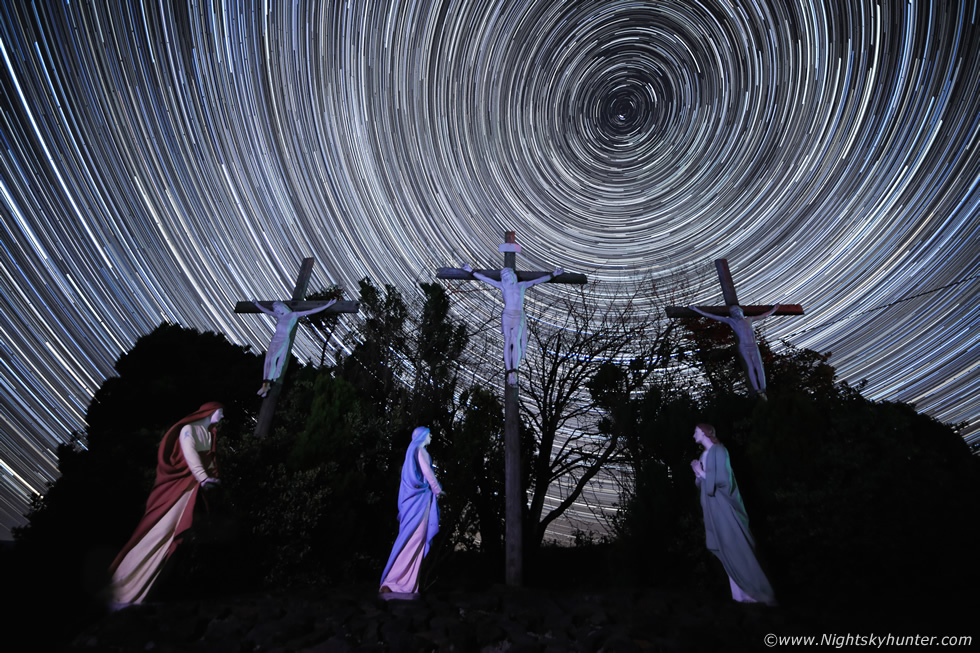 |
This was the resulting star trail from two hours of constant 15 second exposures, you can clearly see Polaris to the upper right marking the location of the north celestial pole. I was pleased with the trail, the dew heaters performed flawlessly and the time lapse ended up perfect too.
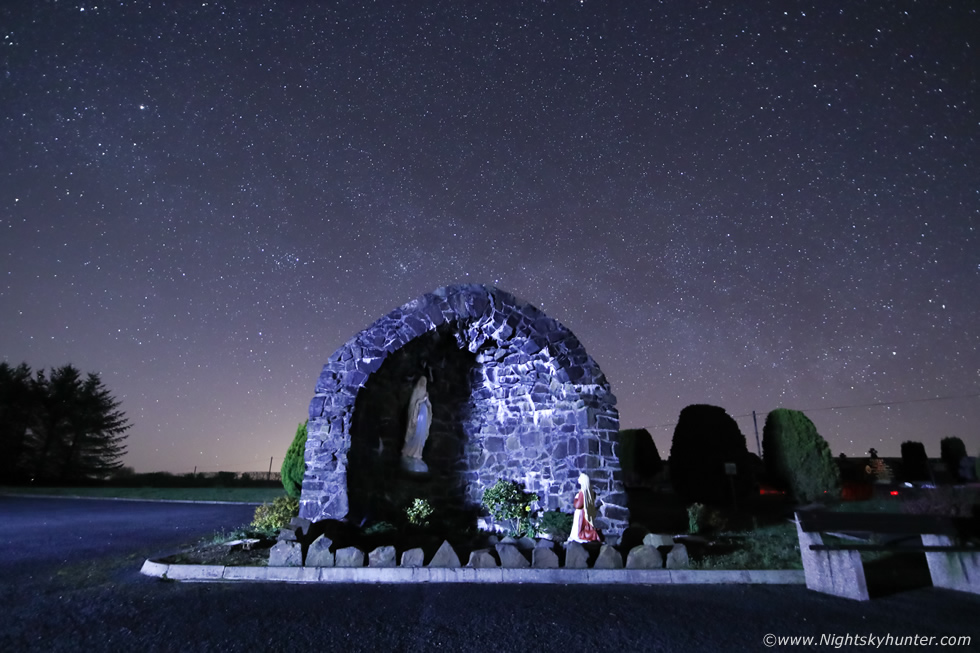 |
While I had the camera in hand I took a few more exposures, this was the shrine to Our Lady with Milky Way. The Double Cluster is visible above the stone structure with loose open cluster Melotte 20 near Alpha Persei (Mirfak).
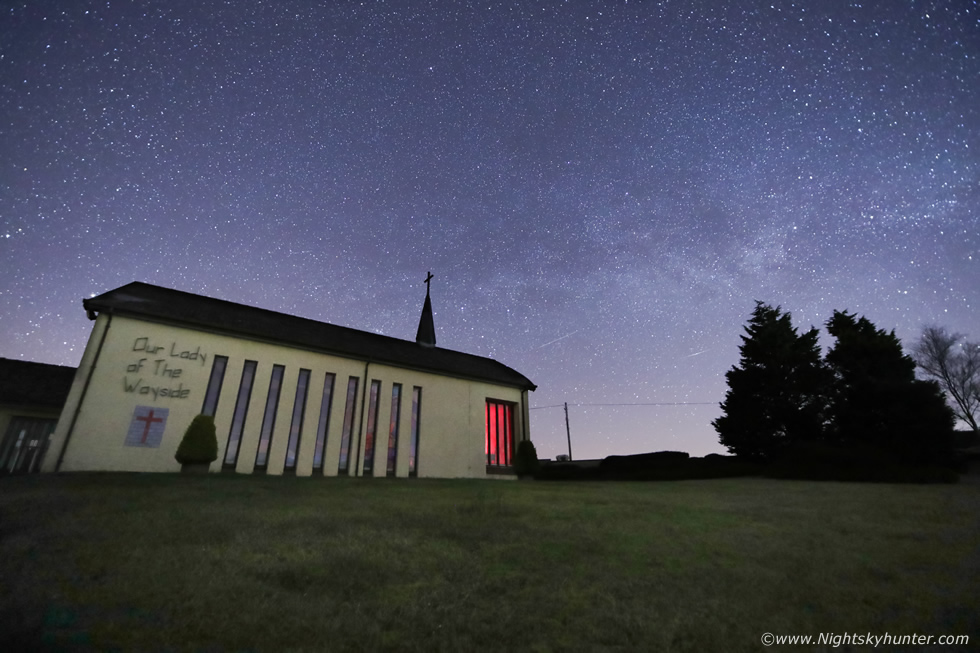 |
Single exposure of Our Lady Of Wayside chapel at Broughderg with pre-dawn Milky Way between Cygnus and Cepheus, you can make out dark dust lanes and a hint of the North America Nebula.
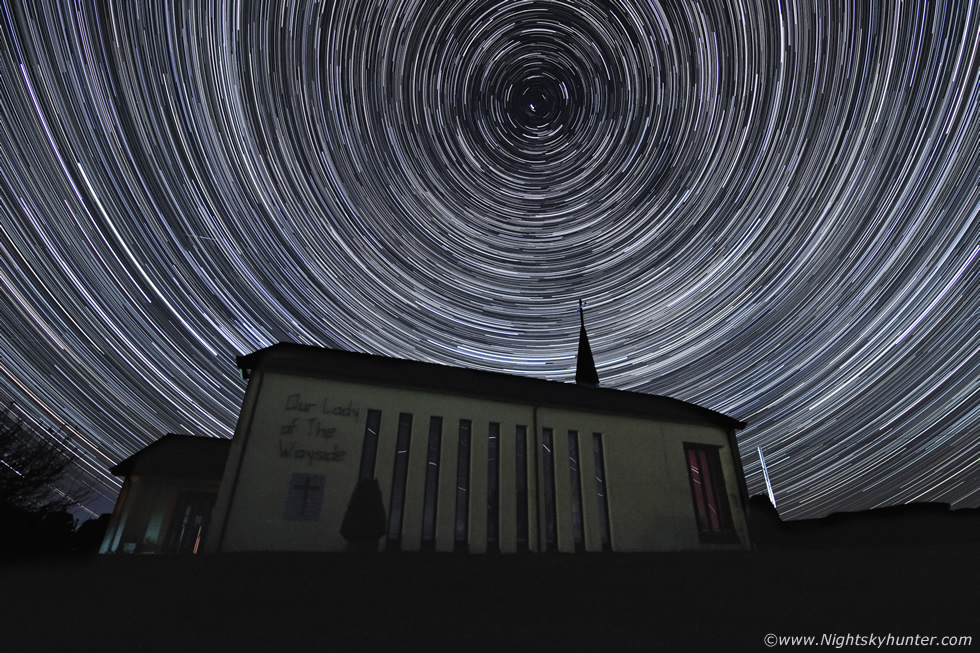 |
Star trail with the older crop sensor Canon 600D with 10mm lens. Two hours of 25 sec exposures at ISO1600 with lens at F/2.8, you can even see star trails reflecting on the windows. Keep in mind this was a dark night away from any light pollution and with no moon the chapel remained in darkness. Finally John and I ended this shoot, we were both freezing, then began the drive home across the frosty back roads, it was a great first night out, we agreed to do more shoots combining the telescopes with cameras in the future.
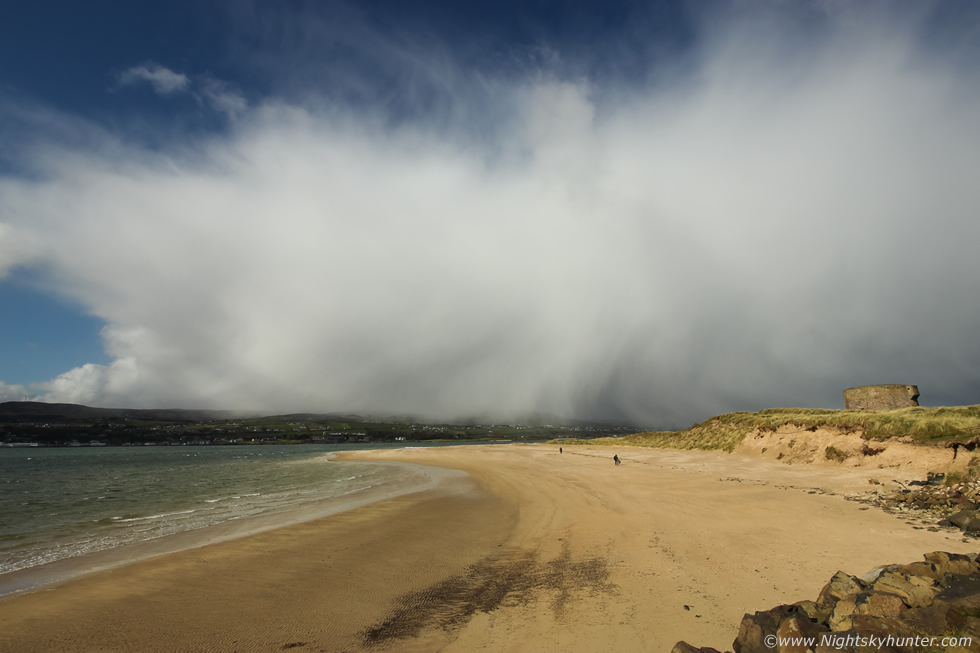 |
On Saturday April 9th we had already planned another night shoot and observing session, I would be meeting Paul Martin and John Fagan later, but I had some daytime interests to monitor first. With an Arctic air mass over us things seemed promising for convection however with high pressure, a capping inversion and weak instability there was no chance of cold air thunderstorms across Ireland, however there were well scattered wintry showers of hail and snow so I was keeping an eye out for something unexpected even though my expectations were low to say the least. However even low chance set-ups can produce photogenic rewards, I happened to be along the north coast and stopped at Magilligan Point to take in the view.
It was a gorgeous sunny day with blue skies and blazing sunshine, if it wasn't for the chilly Nly breeze you would have been forgiven for thinking that it looked like a great Spring day. I spotted an incoming snow showers miles away over the sea, a messy line was visible on radar moving straight towards shore, the western section of the cluster had a red core. I watched as it approached Donegal then made its way over Lough Foyle towards the beach. By this stage it looked dramatic with the entire shower surrounded with blue skies and curtains of snow cascading over Greencastle and the lough itself. The sight of the snow shower with the bright sunlit beach made for a nice moment, it looked like Summer verses Winter captured in a single moment.
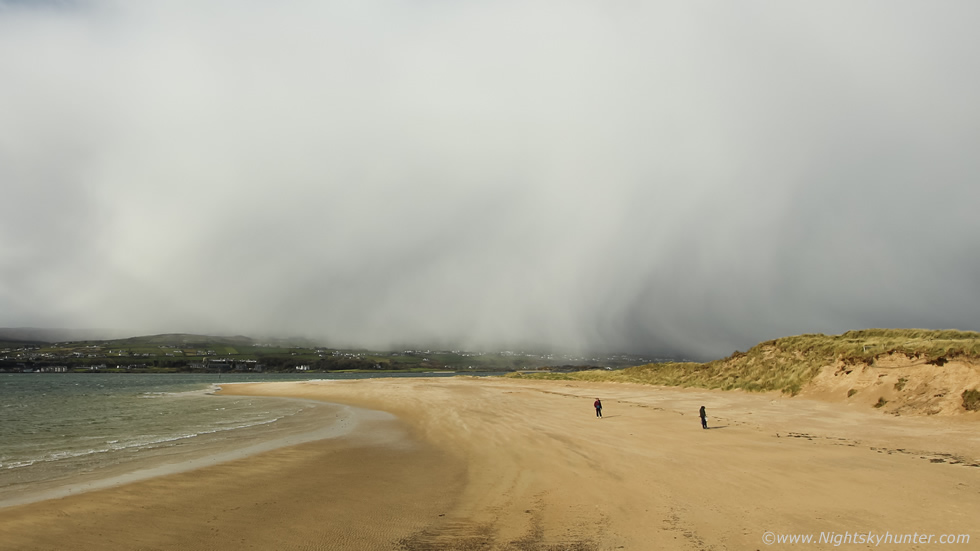 |
I jumped up on the wall beside the Point Bar to get a better angle, the gust front hit and it was brutal with +20mph ice cold wind cutting through all my layers. Seeing snow from a beach is always a 'cool' experience.
As dusk arrived later that same night I was back out under the stars for the second night shoot of the season, I had just met Paul Martin at Beaghmore Stone Circles for a night of general shooting, I had also brought the scope along for visual observing later. Yet again the night was very clear with moderate to good transparency and dark moonless skies, very cold and calm, a frost was descending fast within the grounds of the circles as Paul and I walked about in the dark taking in the sky while sussing out new angles within this famous location. We spent a good hour taking random images and even met with a few first time visitors to the site who had never been under a dark sky before. We ended up pointing out a few celestial treasures such as the Double Cluster, Polaris, Cassiopea and Ursa Major.
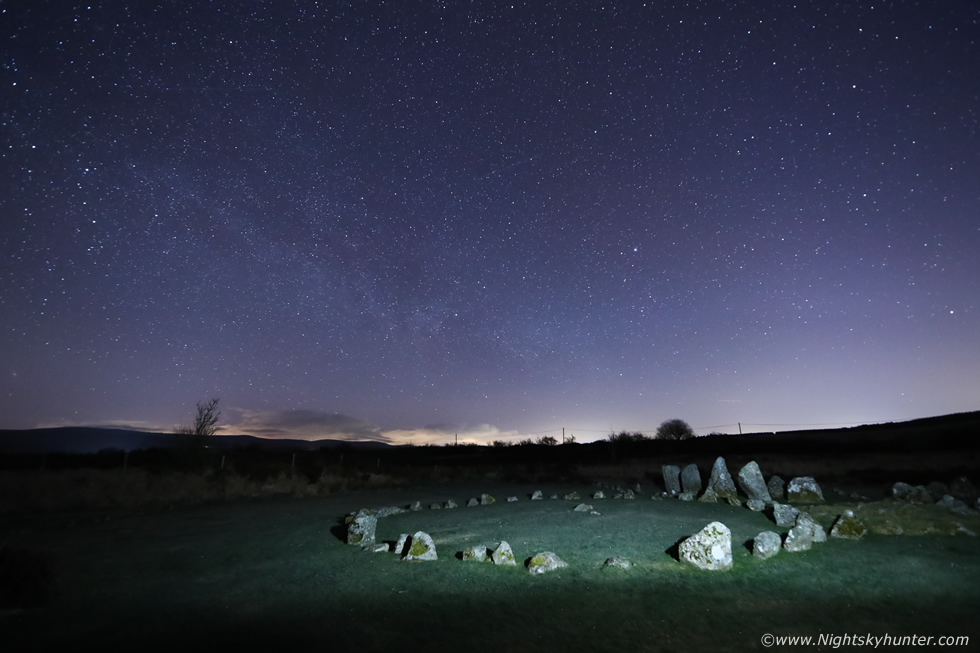 |
Later John Fagan arrived just as a moderate frost coated the grass, we decided to shoot one of the complete circles with the Milky Way above, this was International Dark Sky week so we wanted to take advantage of the trend to showcase our skies and famous observing locations here in Co. Tyrone. Paul and I shot stills while John took a series of tracked exposures using his tracking mount. We experimented by 'light painting' the stones with our head torches to bring up the foreground. Normally I would choose a moonlit night for this but since dark skies were the main theme we had to improvise, it has been a long time since I've done any light painting like this however I ended up really enjoying the process.
This is a single exposure with the full frame at 15mm stopped down to F/3.0 at ISO6400 for 25 sec's. The Milky Way over this 5000 year old stone circle would have been the same sight the stone makers would have seen at this exact time of night at this time of year. The main constellations would have changed but little during this time and the Milky Way would have looked the same, but skies would have been much darker back then of course with no man made lights from distant towns introducing sky glow. Between then and now little would have changed, however careful watchers of the skies, and they would have been back then, would have noted changes from time to time, brief interruptions to the starry firmament such as Comet apparitions, the stirrings of Variable Stars, streaking Meteors and Fireballs, grand displays of the Aurora Borealis, Noctilucent Clouds and the occasional Nova.
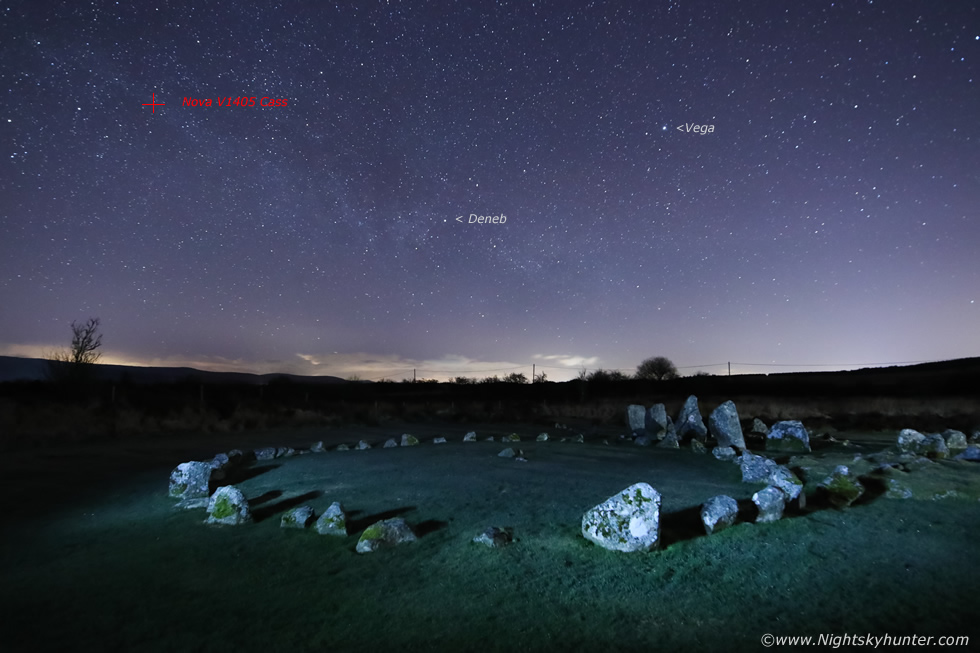 |
As chance would have it one such stirring was actually in the process of happening this night in 2021, a transient event too faint to be seen with the naked eye but visible in modern binoculars and cameras. A Nova had recently been discovered in the constellation of Cassiopeia the celestial 'W' and had peaked at mag +7.9 in the region of sky close to open star cluster M52. The Nova was discovered on March 18th by Yuji Nakamura from Japan at mag +9.6 using a camera with 135mm lens to conduct photographic patrols of the sky, on the previous day there was nothing visible above mag +13. The Nova brightened rapidly to within binocular range and is still in outburst. It was soon designated as Nova V1405 Cass by the IAU and observers all around the world have been observing it ever since. I have marked the Nova's position in red in the above image. A stellar explosion over Beaghmore Stone Circles was a great way to celebrate dark sky week.
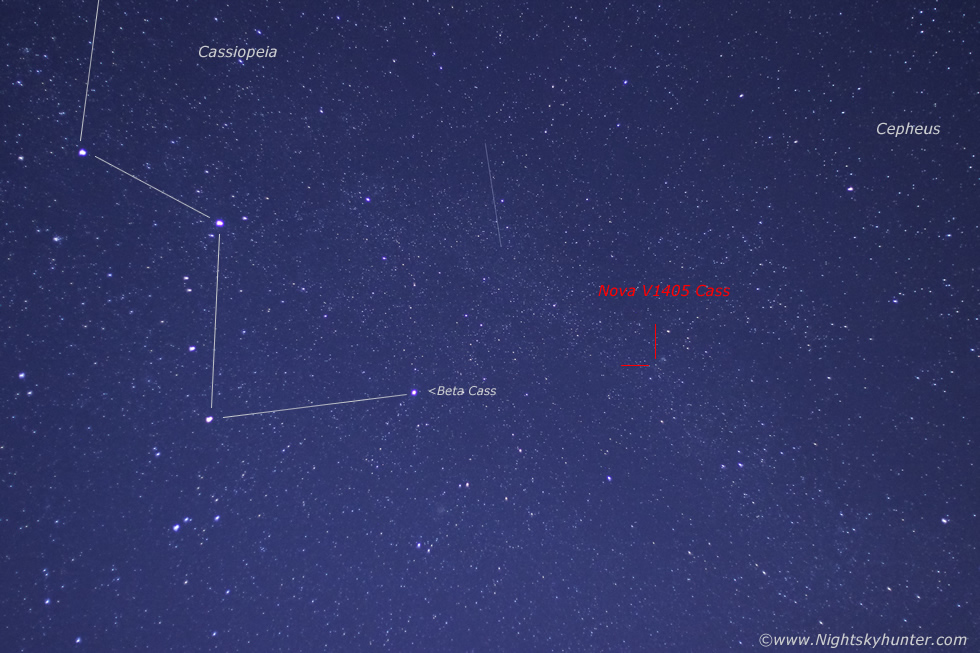 |
With the 600D and 50mm F/1.8 lens I obtained close in exposures of the field. The Nova is between Cassiopeia and Cepheus only a few degrees from the naked eye star Beta Cass.
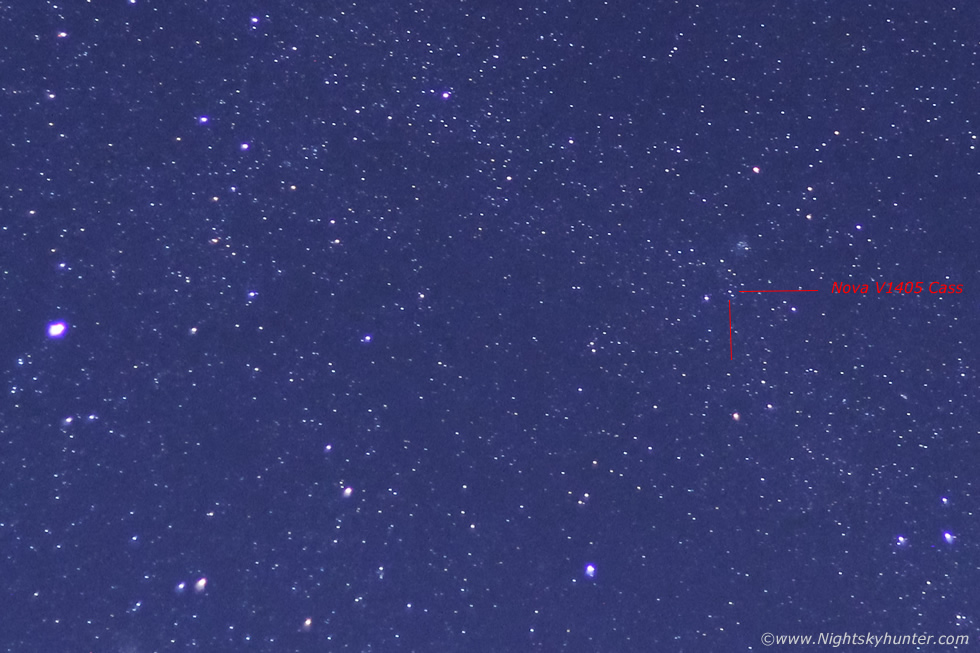 |
To the watcher of the skies a Nova looks like a new star which has suddenly appeared, a bright Nova can break up the shape of a familiar constellation and be a startling sight such as Nova Cygni of 1975 which peaked at mag +1.7 like a bright new star above the Northern Cross in Cygnus. Many independent discoveries were made on the night it made its appearance all across the world as darkness fell and many sent in their observations to the CBAT, my good friend and astronomer John C. McConnell from Maghaberry was one of these observers, his report ranked at number 50 in the world.
I have observed a number of binocular and one naked eye Nova in Aquila back in 1999 however I hope to some day witness a brilliant 'new star' in the midst of the Milky Way galaxy. Novae can take us by surprise, on one night nothing is visible at the limit of any telescope then hours later a naked eye star can be shinning, these stars are violent with enormous flare ups. In truth a Nova is actually a binary star system which consists of two suns in orbit around each other, often one is a large red giant while the second is a smaller but more dense companion which draws material from the larger companion into an accretion disk around the smaller star, a limit is reached and a thermonuclear explosion takes place causing the smaller star to brighten significantly, this is what we see as a Nova. The above image is a deep crop showing the Nova and M52.
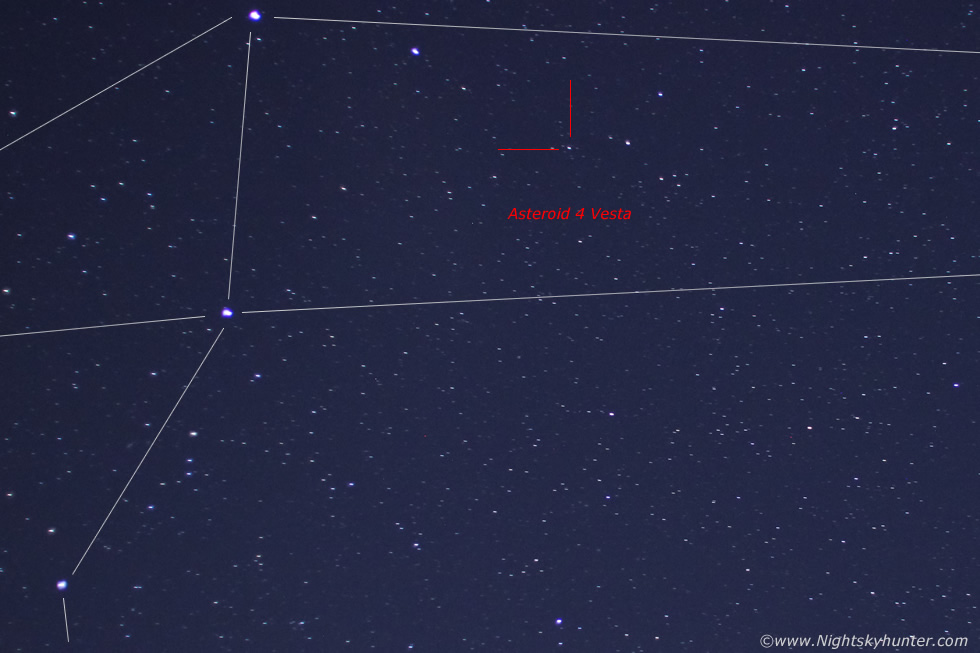 |
While I was using the 50mm lens I pointed the camera to Leo the celestial Lion located on the ecliptic plane and captured Asteroid 4 Vesta at approximately mag +6.5. This asteroid is the brightest in the night sky and visible in binoculars and at its best it can be glimpsed with the naked eye from dark locations if you know exactly where to look. You can use a star chart to identify the asteroid or simply sketch or photograph the suspected field then return the next night, or several nights later, and examine the field once more, you will notice that one of the stars has moved relative to the background stars, this is your asteroid. Vesta is located within the asteroid belt between Mars and Jupiter and is 525km in diameter, capturing a massive space rock moving through our solar system with humble gear us always a thrill.
We went back to the car park and warmed up for 30 min's then got the telescope out for another session. It was 02.00 and I was waiting on a new comet to rise in the eastern sky. In the meantime I showed Paul a selection of deep sky objects in the 10" such as M13, M92, M57, M27, M81, M82, M104, the Needle galaxy in Coma Berenices and NGC4631 and companion in Canes Venatici. My scope's optical performance was not great this night, the FOV exhibited coma, light fall off at the edges and the stars at centre were more like small blobs than points of light, the culprit was that the collimation (alignment) was out, most likely as a result of driving over bumps on the road on the way down. I didn't have time to mess about with alignment so I put up with it for the remainder of the session.
My cometary prey was now rising into view within the constellation of Aquila the Eagle and I was eager to see it. I began a careful sweep through the suspected area but nothing could be found, this was surprising considering the scope's capabilities however we did notice that there was haze and light pollution in the same area plus the sky regions low proximity in the sky affected by atmospheric extinction made detection extra difficult. However I never gave up and after two sessions I found what I was hunting for - comet C/2020 R4 ATLAS. The comet was mag +9.5 and located to the SW of the wing tip of the Eagle in a sea of stars. The comet was had no tail and was barely visible above the background sky as an elliptical haze with no condensation visible, it was also rather diffuse at D.C: 4. John and Paul took their turns at the eyepiece and also spied the visitor, they both agreed it was faint and a challenging object but were delighted to have seen it. This was my first comet observation of 2021 and the first comet spied with the new telescope so the scope is now well and truly broke in. On that high note we packed up and called it a night as we drove home over a frost at -3C.
 |
The unstable cold air was still over us the following day and Convective Weather had a low risk outlook issued for Ireland and NI due to the showery air mass. With solar heating, slack Nly wind profiles and -30C air aloft convection would form bringing well scattered hail and snow showers, the outlook also mentioned convergence zones and hence a chance of funnel clouds. I didn't expect much to be honest but I was still on guard as I made my way to Maghera to take my Mum out for a drive. We where just passing to the north of Maghera close to the Coleraine road when I spotted a dramatic sky which was worthy of shooting so I pulled over onto a grass verge and got out for images.
This low topped cell looked rather impressive, it was moving from L to R here and on the R was a core of hail stones and snow. A well defined updraught base had formed under the flanking region with a lowering directly under the updraught where inflow was drawing moisture into the base, it was a scene more akin to a Summer storm than a Winter Cb. The lowering really got my attention, the fingers of scud seemed to probe the surface, the entire moment looked photogenic with the cell over this sunlit field with a local farm house for added interest. This was super wide angle with the 15mm on full frame.
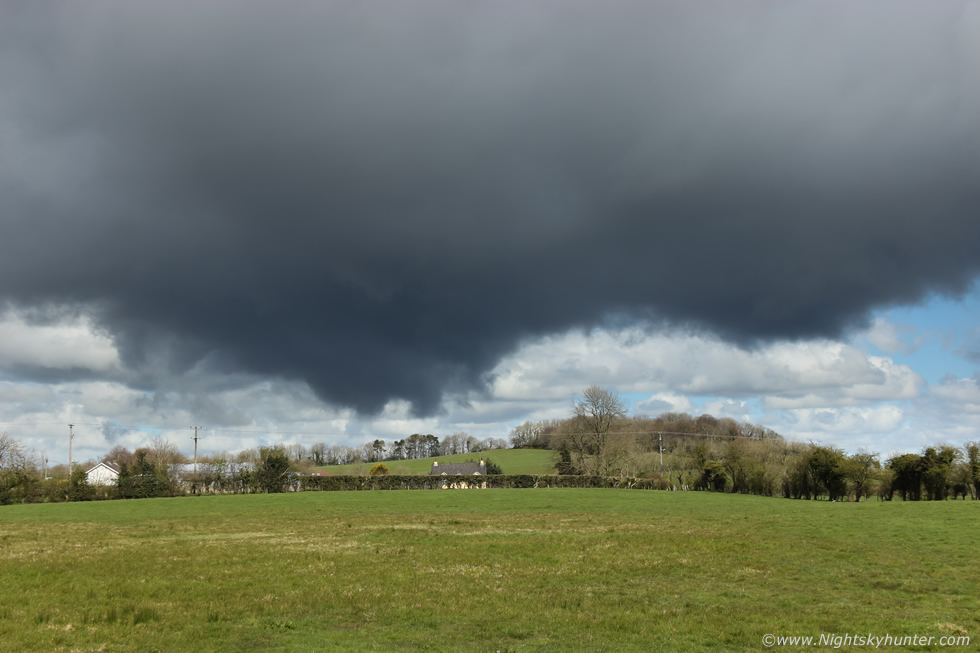 |
I was now using the 18-55mm lens on the crop sensor, this looked more like the naked eye scene. The lowering was almost touching the roof top, at a casual glance one would be forgiven for thinking this was a ragged wall cloud under a rain free base.
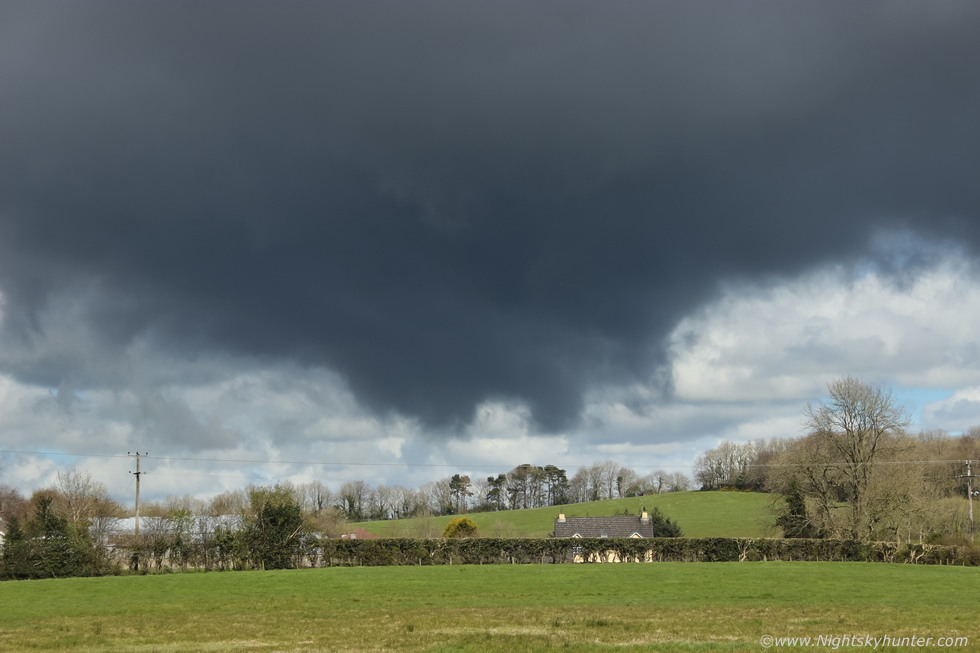 |
At 55mm plenty of detail could be seen, from my visual perspective those beefy scuddy lowerings were swirling and churning while exhibiting upward motion all at the same time and I was honestly half expecting to see a funnel cloud form at any moment. The motion was gentle and not aggressive but it was there nonetheless. Ten min's later the cell had weakened and snow flakes were falling from the sky against a clear blue sky. It was a nice moment and the best convective scene of the season for me so far.
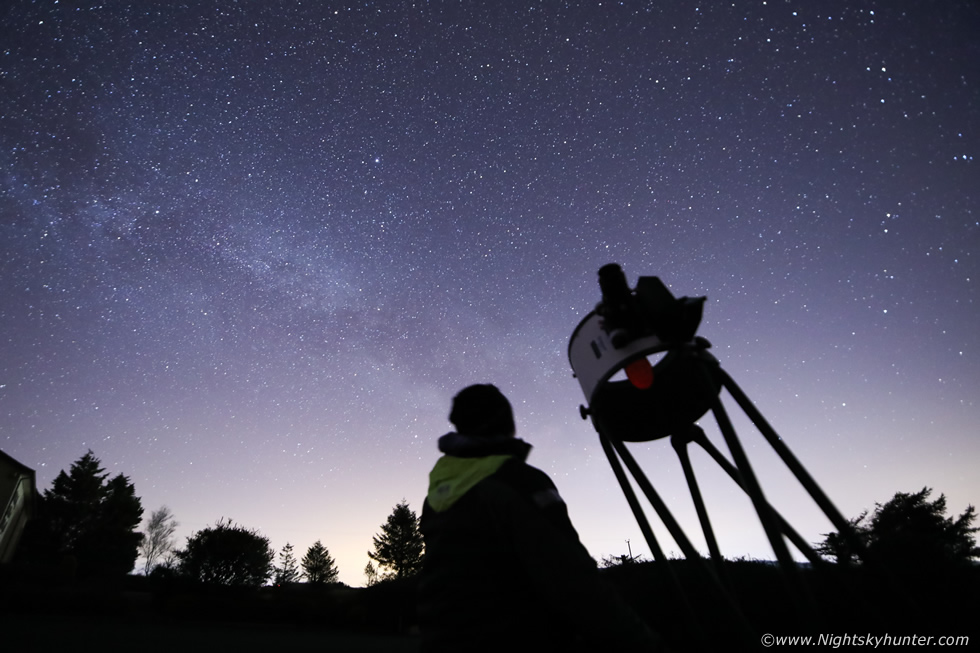 |
On April 15th I decided to go on a solo mid week observing session to take advantage of yet another fine clear night, I wanted to re-visit some old deep sky friends and track down comet C/2020 R4 ATLAS, and of course the 10" reflector came along with me. I left home at 00.50 and drove into the Sperrins back to Broughderg as I was deeply impressed with the quality of the night sky there. I'm glad I made the effort for the sky was remarkable despite an above average transparency of 8/10. I began observing a selection of DSOs with the low power wide angle eyepiece, these were as follows...
M13, M92, Double Cluster, M57, M56, M51, M81, M82, M53 and my new favourite field showing NGC 4656, NGC 4631 and NGC 4627. The latter is very faint however the former two are stunning together. From this dark site this huge edge-on spiral was spectacular with sharply defined tips, central bulge with central disk full of subtle detail such as knots, enhancements and dark dust lanes. Beside it was another such elongated spiral with a hook-like appendage on one end of the spiral arm, this was the result of an interaction event between both galaxies which altered its shape and triggered star forming regions. Some call it the Hockey Stick galaxy but to me it looked more like a celestial fishing lure.
I also observed the faint globular cluster NGC 5053 in the same wide field as M53 its more famous counter part. At low power the former looked like an irregular diffuse haze with a low surface brightness and lacked any central brightening, it looked for all the world like a faint comet at discovery and as such I would highly recommend this as a suitable test object for new comet observers. Of course higher magnification will reveal a mottled texture revealing the objects true identity. I also bagged several new NGC galaxies in Coma Berenices which I have never seen before in my life, even with the 16" telescope which I used many years ago from Maghera.
I hunted down C/2020 R4 ATLAS between Aquila and Serpens Cauda at mag +9.7, it looked like a diffuse elliptical haze with a subtle brightening towards centre with no tail against a rich field of stars at D.C: 3, I could discern a green hue indicative of the gas-rich coma. I finished up by finding comet C/2020 T2 Palomer in Canes Venatici at mag +12, this was surprisingly easy to see due to its position at the zenith and its highly condensed form at D.C: 6, it was a compact oval comet rather well defined. I searched for comets low in the N, NW and NE then did a naked eye session, I could detect Chi Cygni (Mira type long period variable), RCrB (reverse Nova), the North America Nebula, complex dust lanes and divisions within the Milky Way but most impressive of all was seeing Messier 81 with the naked eye!
I had observed M81 without optical aid on two occasions in the past with Conor McDonald approximately 15 years ago from Maghera on nights of exceptional clarity after a cold front, and back then of course Maghera had a much darker sky compared to now. I decided to try for it again as Broughderg looked like a location capable of such a challenge. I centered M81 in the FOV, checked the position of the inner 30' red circle of the telrad then switched it off and sure enough without too much effort I could see M81 with my own eyes. I was thrilled beyond words, in fact, with averted vision I glimpsed it half a dozen times as a 15 arc minute (half the apparent size of the Moon) haze.
Most Astronomy sources will state the farthest object you can see with the naked eye is M31 The Great Andromeda Galaxy, however this isn't true, a little farther away is M33 The Triangulum Galaxy which requires dark skies and knowing exactly where too look, previous DSO observing experience helps. But with exceptional skies M81 is even more distant at 12 million light years!, that's how far you can see with the naked eye. The question however really comes down to how dark your sky is and how much experience you have observing, these last two factors do play a crucial role in these naked eye distance tests. I drove home along the frosty roads feeling happy and content with what the sky had offered me on this very special night. Thanks very much for reading.
Martin McKenna